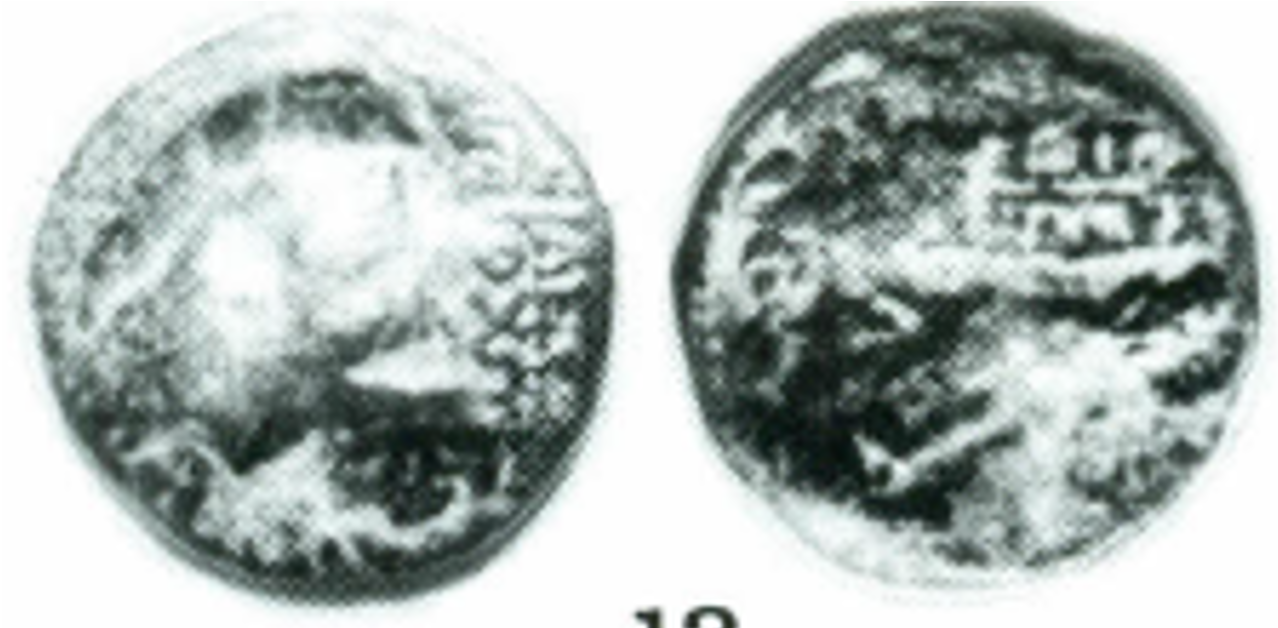80 BCE - 68 BCE | BAΣIΛEΩΣ BAΣIΛEΩN TIΓPANOY
Overstriking coin
Tigranocerta_over_Damas_(Nercessian_1996,_n°13).png
Overstruck variety
Damas_Antiochus_XII_Zeus.png
[1]
Description
| ObverseInscription or printing placed on the obverse.:
|
Bust of Tigranes II to right, wearing Armenian tiara decorated with a star between two eagles and tied with a diadem, drapery on shoulders. Border of dots.
|
ReverseInscription or printing placed on the reverse.:
|
BAΣIΛEΩΣ BAΣIΛEΩN TIΓPANOY Tyche of Antioch seated on rocks right, wearing turreted crown, holding palm branch. At her feet, the upper portion of the river-god Orontes swimming right. In field, letters/monograms. Border of dots.
|
Mint and issuing power
Chronology
| FromIdentifies the initial date in a range assigned in a numismatic context. 80 BCE toIdentifies the final date in a range assigned in a numismatic context.. 68 BCE
|
Hellenistic 323-30 BC  periodTime period of the numismatic object. periodTime period of the numismatic object.
|
Physical description
MetalThe physical material (usually metal) from which an object is made.: Bronze 
|
WeightWeight of the numismatic object (in grams). in grams: 7.887.88 g <br />7,880 mg <br />
|
DenominationTerm indicating the value of a numismatic object. Examples: tetradrachm, chalkous, denarius.: tetrachalkon 
|
|
| DiameterDescribes diameter of an object (in mm).: 2020 mm <br />2 cm <br />
|
|
References
| Coin referenceReference of the Coin:
|
Nercessian, 1996, p. 48, n° 13.
|
Coin series referenceReference to coin series study:
|
Bedoukian 19781Bedoukian 1978, n° 91-98 ("Antioch type", units 1, 2 and 4), Nercessian 19952Nercessian 1995, n° 48-54, Kovacs 20163Kovacs 2016, n° 124.
|
| Coin series web referenceCoin series web references:
|
|
Description
| ObverseInscription or printing placed on the obverse.:
|
Bust of Antiochus right, wearing diadem (visible on reverse)
|
ReverseInscription or printing placed on the reverse.:
|
ΒΑΣΙΛΕΩΣ ΑΝΤΙΟΧΟΥ ΔΙΟΝΥΣΟΥ ΕΠΙΦΑΝΟΥΣ ΦΙΛΟΠΑΤΟΡΟΣ ΚΑΛΛΙΙΝΙΚΟΥ Zeus standing left, wearing himation, holding Nike and scepter (visible on obverse: legend).
|
Mint and issuing power
Chronology
| FromIdentifies the initial date in a range assigned in a numismatic context. 89 BCE toIdentifies the final date in a range assigned in a numismatic context.. 89 BCE
|
Hellenistic 323-30 BC  periodTime period of the numismatic object. periodTime period of the numismatic object.
|
Physical description
References
References
- ^ Bedoukian, Paul Z. (1978), Coinage of the Artaxiads of Armenia, RNS Special Publication Number 10, London, 81 p.
- ^ Nercessian, Yeghia T. (1995), Armenian Coins and Their Values, Armenian Numismatic Society Special Publication 8, Los Angeles.
- ^ Kovacs, Frank (2016), Armenian coinage in the classical period, Classical Numismatic Studies 10, Lancaster, 83 p.
- ^ Gardner, Percy (1878), A Catalogue of the Greek coins in the British Museum. vol. XXII : The Seleucid kings of Syria, London, The Trustees, p. 126, pl. 28.


